David Parker isn’t one to sit idle. He’s a woodworker, a cook, a musician, a luthier, and a knife-maker, so when the pandemic kept him from going to his job at a musical-instrument wholesaler and confined him to quarters, he wasn’t going to let hours slip by binge-watching his DVD collection of Gilmore Girls. With more time to spend in his shop at home in Oratia, a suburb of Auckland, New Zealand, David made a paper canoe. Using an unconventional material wasn’t new to him. Last year he made a bicycle frame out of wood.
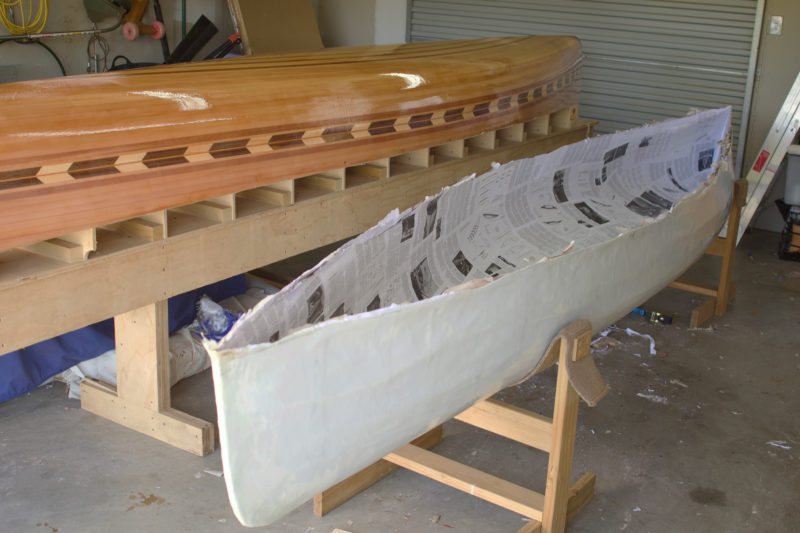 David Parker
David ParkerThe paper canoe was molded over a wood-strip canoe while it was still on the molds.
Laminating paper to make a boat isn’t a new idea. In the 1860s, Elisha Waters of Troy, New York, had a lucrative business making paper boxes, and then in 1867, his teenaged son, George, came to the factory to take advantage of the paper and paste there to make a mask for a masquerade party. At the time, George was also repairing a wooden racing shell, and the proximity of the two projects led him to try using paper and shellac as materials to repair the shell. That worked so well that he considered the possibility of making an entire racing shell that way.
George and Elisha molded paper over a racing shell and created a new hull that was seamless, leakproof, light, and strong. They made three more hulls and realized they were onto something, and patented the idea. The following year, Elisha got out of the box business and his factory became the home of E. Waters & Sons, Paper Boat Builders. The company produced racing shells, revolutionary monocoque hulls that dominated collegiate regattas.
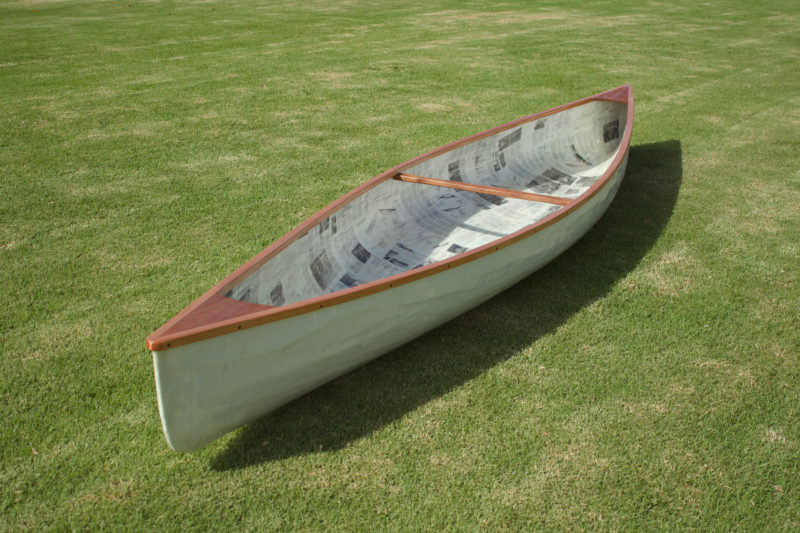 David Parker
David ParkerThe canoe’s wooden elements—gunwales, decks and thwart—give the hull stiffness, just as they do in ordinary canoes.
The Waters company also made paper observatory domes and paper cruising boats, including the canoe made famous by Nathaniel Holmes Bishop in his book, Voyage of the Paper Canoe, published in 1878. The company continued in business until 1901, when George accidentally started a devastating fire in the factory while working with a blowtorch. He died the following year, followed by the death of Elisha in 1904. Their technology went with them and the exact combination of paper and adhesive they used remains unknown.
In recent times, many amateur boatbuilders have made paper canoes using available materials. I gave it a shot many years ago and tried kraft paper, brown paper towels, Handi-wipes, Weldwood glue, carpenter’s glue, polyester resin, and epoxy.
David’s path to building a paper canoe began in 2013 when he took an interest in woodworking. He borrowed tools from his brother to build a lap steel guitar. He enjoyed the woodworking, started to set up a shop in his garage, and built more guitars.
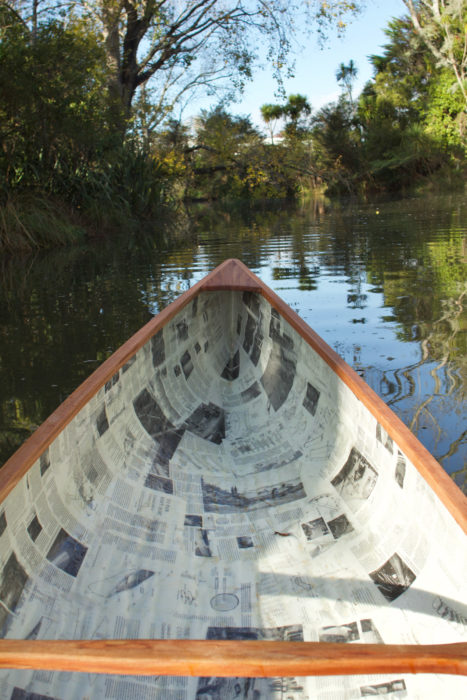 David Parker
David ParkerIf the scenery doesn’t capture David’s attention, he can brush up on strip-building from the pages of the book, Canoecraft, which make up the inner layer of the canoe.
Parks and Recreation was another of his favorite TV series, and he stumbled upon a YouTube video featuring one of the show’s stars, Nick Offerman. In the video, Offerman was building a Bear Mountain Boats strip-built canoe. David had no interest in paddling a canoe, let alone building one, but he liked the idea of building something larger than a guitar and was intrigued by the aesthetic possibilities offered by strip construction. He ordered a Prospector 16 kit from Bear Mountain Boats in Ontario and finished building it in 2017. Not long after he got it afloat, he discovered that he loved paddling.
This year he ordered plans for a Freedom 15 from Bear Mountain and bought his materials from local sources. He discovered that the fiberglass he had purchased was too narrow to cover the canoe, so he placed an order for the right size and used that to sheathe the hull. Rather than let the first order of fiberglass go to waste, he decided to use it in the building of another canoe. He had seen a paper canoe on Instagram and was intrigued by the construction, thinking that paper could serve as a core between layers of ’glass, just as cedar strips do.
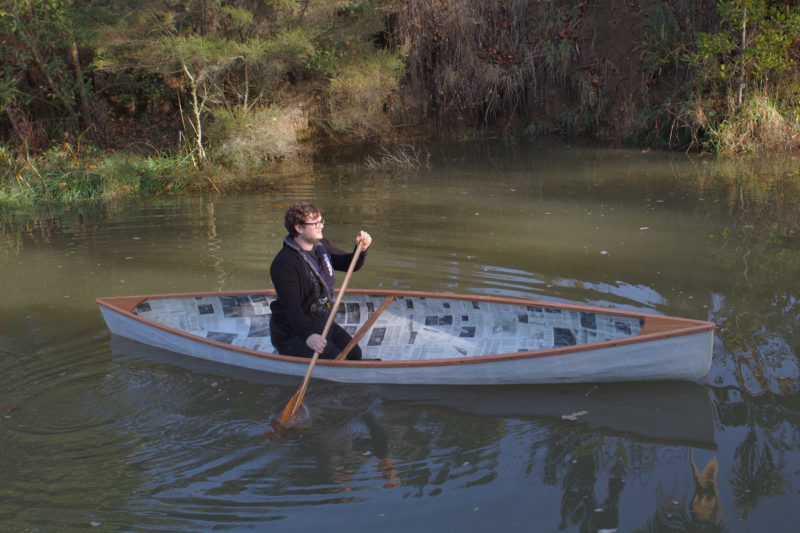 Jane Parker
Jane ParkerWhile David is waiting for bolts to hang a canoe seat from the gunwales, he paddles the canoe kneeling.
The lockdown in New Zealand began on March 23 and David stayed home to do his part in slowing the spread of COVID-19. He focused on his canoe projects and covered the Freedom 15 with plastic sheet to use the unfinished canoe, still on its building form, as a male mold for a paper canoe. The canoe he’d seen on Instagram was made of newspaper, and that’s what he decided to use for his canoe. The first layer to go on the mold would be the one visible in the interior of the finished canoe, so David decided he’d pay tribute to Ted Moores’ Canoecraft, the book that introduced him to canoeing. Using water-diluted white PVA glue to saturate and bond the paper, David followed the layer of pages cut from a copy of the book with a layer of white paper, eight layers of newspaper, and a final layer of white paper. The 6-oz fiberglass that led to the project, set in epoxy, completed the layup inside and out. David used Victorian ash from Australia for the gunwales and reclaimed New Zealand kauri pine for the decks and thwart.
David is waiting on bolts so he can install a seat, but he has been out for a few test paddles, paddling while kneeling. The hull is a bit rippled and not as fair as he would have liked, but there’s a lot of good reading inside.![]()
Do you have a boat with an interesting story? Please email us. We’d like to hear about it and share it with other Small Boats Magazine readers.
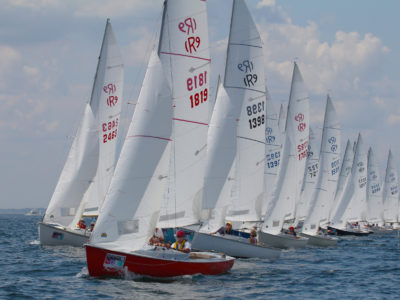
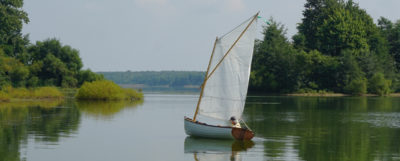
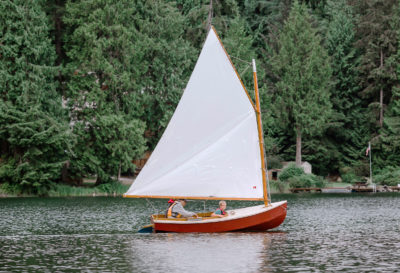
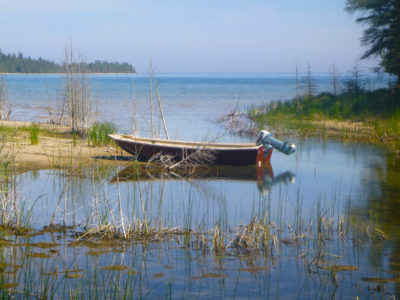
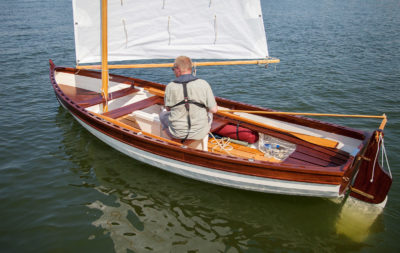

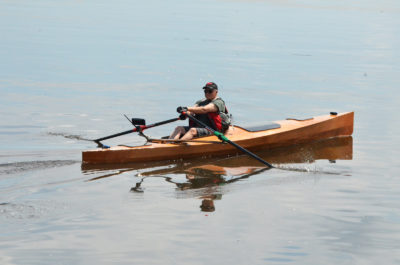
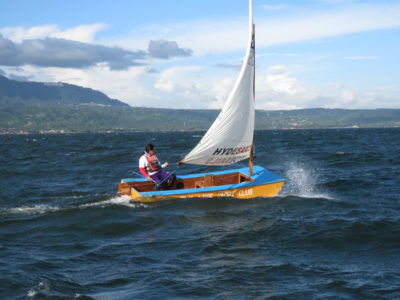
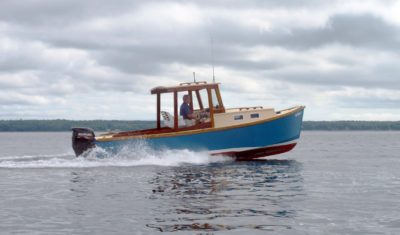
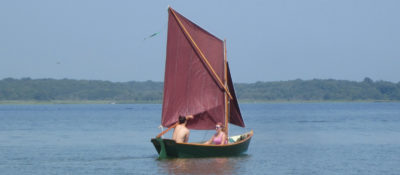
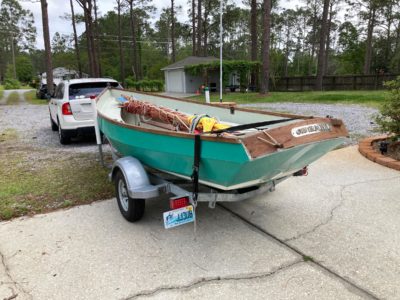
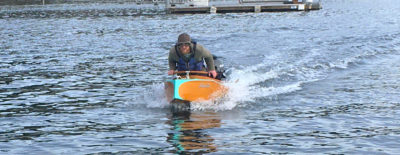
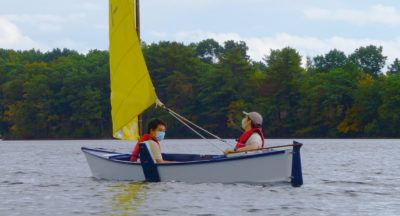
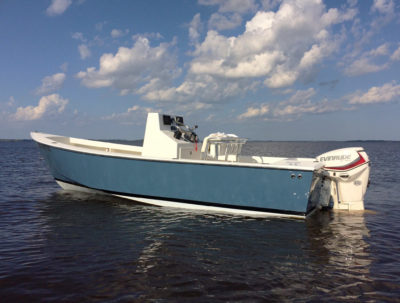
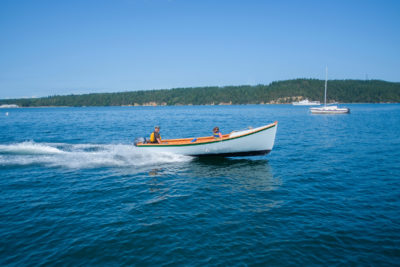
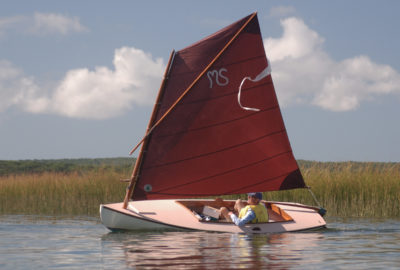
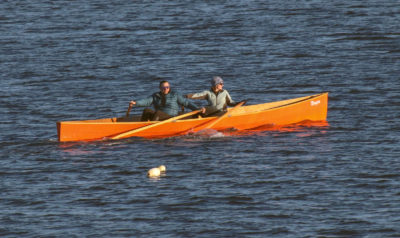
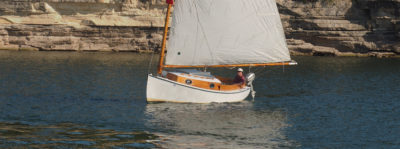
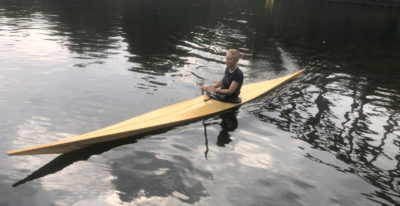
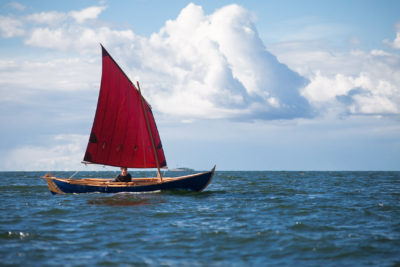
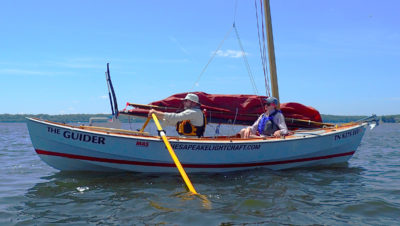
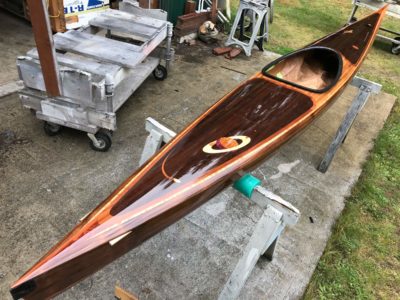
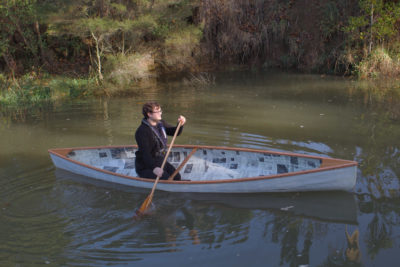
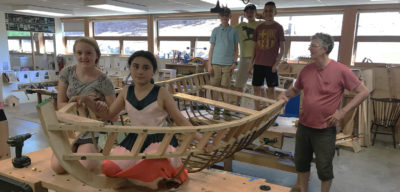

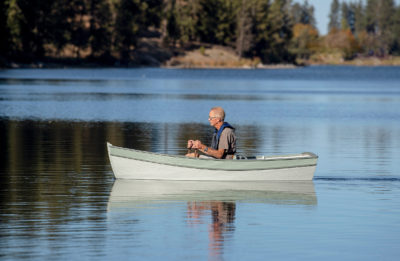
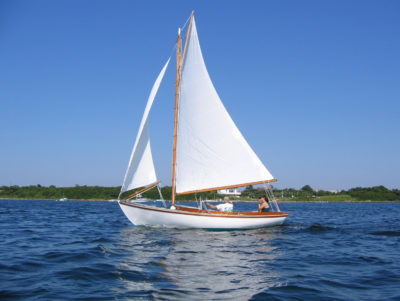

Nice job! I love the fact that a boat can be made from pretty much anything.
Curious. What did the final weight come out to?
What is the resin? Doesn’t look like shellac – unless it’s painted. (A related question – a little off the subject, but highly significant: what resin did Henry Ford use in his hemp car bodies?)
David used PVA glue, diluted with water to help saturate the paper. I used urea-formaldehyde for my first attempt. It saturated the paper and bonded layers very well, but when it cured it warped and was as brittle as slate. For my second attempt I used yellow water-resistant carpenter’s glue—Titebond aliphatic resin. It wasn’t at all waterproof, so small nicks in the epoxy-saturated outer layers softened the laminate. That was in the early ’80s. The newer version of Titebond III might fare better. When I rebuilt my paper canoe after 500 miles, I used polyester resin and that held up well for the 2,000 miles I had to paddle.
I hadn’t heard of Ford’s hemp auto bodies. I’d be eager to know what he used.
We used TiteBond III and acrylic to sheath our live-aboard’s decks four years ago, topped with latex primer and house paint. And they’ve been totally satisfactory.
Primer went on ‘green’ while the TBIII was just shy of set.
I’m thinking this would work great with paper, too… maybe a long-fiber paper with a loose binder?
TBIII doesn’t recommend continuous immersion, but we’ve had no issues where it is in and out of solid water.
Interesting concept. I made several model boats as a teenager, making a framework of balsa and thin strips of bamboo. I then covered the framework with paper saturated with model airplane dope. The models were quite durable. I still have a model tugboat that I built around 1953, which was originally a working model with a small electric motor. It’s only about 9 1/2” long.